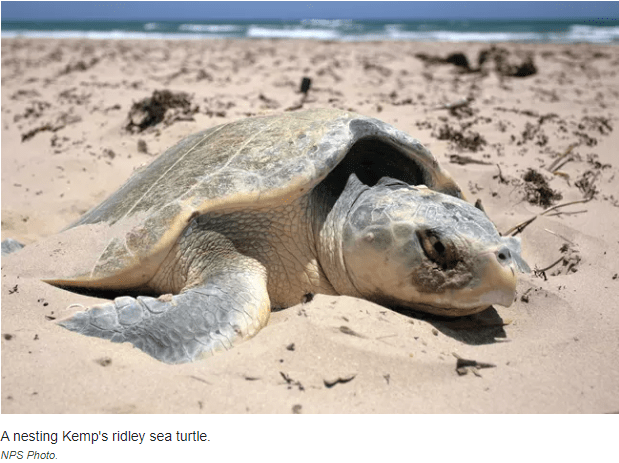An endangered and rare Kemp’s ridley sea turtle laid her eggs at Huntington Beach State Park, S.C. this past Wednesday.
Members of South Carolina United Turtle Enthusiasts (SCUTE) found the nest. SCUTE is a team of volunteers who protect sea turtle nests. The group posted:
Huntington Beach State Park gets a rare Kemps Ridley sea turtle nest! Just hours ago, Ranger Mike announced finding the rare crawl and nest on the HBSP beach. The Kemps is the most rare of the species that we track. Last year for example, out of 6596 nests in South Carolina, there was only one Kemps nest found in the state (Hilton Head Island) and this year the only other KR nest recorded so far is at Botany Bay Island *. Congratulations HBSP and SCUTE family! (Did I say “rare” enough ?)
The Kemp’s Ridley sea turtle, scientifically known as Lepidochelys kempii, is one of the smaller species of sea turtles and also among the most endangered. Nesting primarily along the Gulf of Mexico, these turtles have a fascinating life cycle and face numerous threats that have led to their precarious status. In this comprehensive guide, we’ll explore the world of the Kemp’s Ridley sea turtle, its importance to our ecosystems, and the conservation efforts taking place to ensure its survival.
Understanding the Kemp’s Ridley Sea Turtle
The Kemp’s Ridley sea turtle is distinctive for its olive-gray color and heart-shaped shell, known as a carapace. This species is critically endangered, with its population having plummeted due to human activities.
Characteristics and Behavior
Kemp’s Ridley sea turtles are known for their unique mass nesting behavior called “arribada,” which means ‘arrival’ in Spanish. During these events, thousands of female turtles come ashore simultaneously to lay their eggs. This spectacle primarily occurs along the beaches of Rancho Nuevo in the Mexican state of Tamaulipas, although they can also be found nesting in smaller numbers along the Gulf coast of the United States, including areas like Huntington Beach State Park SC.
Habitat and Diet
These turtles typically inhabit the shallow coastal areas of the Gulf of Mexico but are known to migrate as far north as Nova Scotia. Their diet consists mainly of crabs, but they also consume jellyfish, mollusks, and a variety of other marine organisms.
The Plight of the Kemp’s Ridley Sea Turtle
Despite their fascinating nature, Kemp’s Ridley sea turtles face numerous threats that have led to their endangered status.
Human Impact and Threats
The primary threat to the Kemp’s Ridley sea turtle is human activity. Incidental capture in commercial fishing gear, particularly shrimp trawls, has had devastating impacts on their population. Additionally, coastal development and pollution have degraded their nesting beaches and foraging grounds.
Conservation Efforts
In response to the steep decline in their numbers, conservationists have implemented various strategies to protect this species. Efforts include the use of turtle excluder devices (TEDs) on fishing nets to allow trapped turtles to escape, strict protection of nesting beaches, and head-start programs where hatchlings are raised for a period before being released into the wild.
The Role of Huntington Beach State Park SC
Huntington Beach State Park in South Carolina has now become an important site for the conservation of the sea turtle. Volunteers and park staff monitor the beaches for nesting activity, protect nests from predators, and educate the public about the importance of conservation efforts.
The Importance of Conservation
The decline of the Kemp’s Ridley sea turtle has broader implications for marine ecosystems.
Ecosystem Impact
Sea turtles play a vital role in maintaining the health of marine environments. For example, their grazing helps to regulate the growth of seagrass beds and their predation on jellyfish helps to keep those populations in check. The loss of the Kemp’s Ridley sea turtle could have cascading effects throughout the ecosystem.
The Global Effort
Conservation of the sea turtle is a global endeavor, with countries around the Gulf of Mexico and beyond participating in efforts to protect this species. International cooperation is crucial, as these turtles do not recognize political borders in their migrations.
Responsible Beach Habits
If you live near or visit coastal areas, be mindful of your impact on the beach. Keep beaches clean, dispose of trash properly, and avoid disturbing marked sea turtle nests. During nesting season, minimize beachfront lighting, which can disorient hatchlings making their way to the sea.


